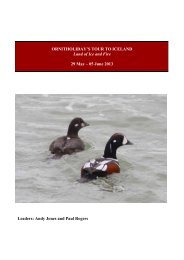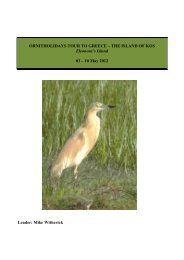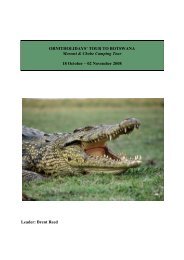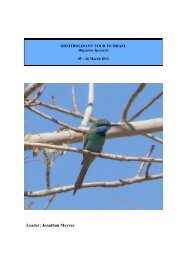Download 2014 Brochure (.pdf) - Ornitholidays
Download 2014 Brochure (.pdf) - Ornitholidays
Download 2014 Brochure (.pdf) - Ornitholidays
You also want an ePaper? Increase the reach of your titles
YUMPU automatically turns print PDFs into web optimized ePapers that Google loves.
F R A N C E<br />
France – The Camargue,<br />
the Cévennes & Causses at Leisure<br />
Birds & Butterflies<br />
Sunday 25 May – Sunday 01 June <strong>2014</strong><br />
Principal Leader: David Walsh<br />
<strong>2014</strong> Cost: £1,799 single room supplement £150<br />
FRANCE<br />
Paris<br />
Le Pont<br />
or over 40 years we have been taking birdwatchers to the Camargue in southern France, the delta of the Rhone. de Montvert<br />
FIt is famous not only for its black bulls and white horses but for its superb birdlife, most notably the large<br />
Beaucaire<br />
population of Greater Flamingos. Our excellent knowledge of the accessible marshes, lakes and reedbeds should Montpellier<br />
help us find an assortment of herons, with all the European species breeding here, as well as colourful favourites such<br />
as European Bee-eater and European Roller. Just across the Grand Rhone lie the semi-desert plain of La Crau and the<br />
picturesque limestone hills of Les Alpilles with a very different range of birds from the Camargue including Lesser Kestrel,<br />
Little Bustard and Short-toed Eagle as well as a variety of other wildlife. For the second part of our holiday we visit the Cévennes<br />
and Causses, areas we have also visited on many occasions. The Cévennes Mountains form the watershed between the river systems of the Rhone<br />
and Soane in the east, and the Garonne and the Loire in the west, and we explore hill, valley and woodland areas which harbour species such as Citril<br />
Finch, Ortolan Bunting and Rufous-tailed Rock Thrush. A little further west, the Causses (from the French chaux, meaning limestone), were formed in the<br />
Jurassic period, and are karst plateaux with an impressive array of raptors including re-introduced Eurasian Griffon Vultures. For plants and butterflies the<br />
Cévennes and Causses is probably one of the best regions of France, with over a quarter of the total species for the country occurring here, including<br />
numerous orchids. Throughout our trip we will ensure the style is relaxed so that there is plenty of time to enjoy the splendid variety of wildlife and scenery;<br />
we use two well-chosen hotels with birding on the doorstep and excellent cuisine.<br />
ITINERARY<br />
Days 1 to 4<br />
We take a scheduled flight from London to<br />
Montpellier and transfer to Hotel Robinson in<br />
Beaucaire, our base for four nights; we have been<br />
visiting this hotel for over 30 years! The food is<br />
exceptional, wine being included with the meals.<br />
With pine forest behind the hotel and riverine<br />
woodland in front, European Roller, Eurasian<br />
Golden Oriole, Cirl Bunting, Sardinian, Cetti’s and<br />
Melodious Warblers, Common Nightingale,<br />
Common Redstart and Red Squirrel are amongst<br />
the possibilities as we stroll from our rooms.<br />
Although in a short visit we cannot hope to see<br />
all of the Camargue, we shall visit a sufficiently<br />
wide range of habitats to give a real taster of this<br />
famous area. The vast reedbeds and shallow<br />
lakes are home to Western Marsh Harrier, Blackcrowned<br />
Night Heron, Purple and Squacco<br />
Herons, Great Egret, Red-crested Pochard,<br />
Savi’s and Great Reed Warblers and Bearded<br />
Reedling, and the new visitor centre at<br />
Scamandre provides an ideal base from which to<br />
explore before enjoying one of our sumptuous<br />
hotel picnics! The flooded rice fields near Mas<br />
d’Agon attract groups of Glossy Ibis as well as<br />
Mediterranean Gulls, Black-winged Stilts and<br />
both Gull-billed and Whiskered Terns. The<br />
spectacular flocks of Common Swifts sometimes<br />
number several thousand, inevitably attracting<br />
the attention of the local Eurasian Hobbies!<br />
Nearby, if we are lucky, we may find a colony of<br />
Collared Pratincoles on the barren fields or a<br />
Great Spotted Cuckoo in a roadside copse.<br />
On the semi-saline Etang de Vaccarès which forms<br />
the geographical centre of the Camargue we can<br />
enjoy close views of its iconic bird, the Greater<br />
Flamingo: thousands occur in this area. As we<br />
head further south towards the Mediterranean Sea,<br />
the lakes and saltpans may produce Slender-billed<br />
Greater Flamingos<br />
128<br />
For a previous tour report or further information please call: 01794 519445








